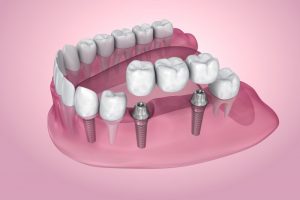 After seeing yet another picture of yourself with a close-lipped smile on social media, you’ve finally decided to do something about your missing teeth, namely, replace them. You spend a little time researching online and figure out that the treatment you’ll most likely need is called a dental bridge. Simple enough, but there’s one problem—there are two main kinds of bridges, traditional ones, and those that are held in place with dental implants. Both seem to do the job when it comes to restoring missing teeth, but which one is better? Today, we cover all bases when it comes to dental bridges in Massapequa so you can be well-informed about your options.
After seeing yet another picture of yourself with a close-lipped smile on social media, you’ve finally decided to do something about your missing teeth, namely, replace them. You spend a little time researching online and figure out that the treatment you’ll most likely need is called a dental bridge. Simple enough, but there’s one problem—there are two main kinds of bridges, traditional ones, and those that are held in place with dental implants. Both seem to do the job when it comes to restoring missing teeth, but which one is better? Today, we cover all bases when it comes to dental bridges in Massapequa so you can be well-informed about your options.
Tried & True: Regular Dental Bridges
Whether you’re talking about a traditional dental bridge or its implant-retained counterpart, they both share some basic characteristics. They can be used to replace one missing tooth or up to three in a row, and the prosthetic is held within the mouth using the nearby teeth as anchors. These are bonded directly to custom-made ceramic teeth that both look natural and help bring back normal chewing function.
With a regular bridge, the prosthetic is secured in place using dental crowns placed over the teeth on either side of the absent ones–these need to be slightly reshaped in order to fit under the dental crowns. Traditional bridges can be designed to be fixed or removable depending on a patient’s preferences and needs.
Beautiful & Built to Last: Implant-Retained Bridges
The key factor that makes implant bridges different from regular ones is how the prosthetic is secured within the mouth. Instead of dental crowns placed over adjacent teeth, the replacement teeth are stabilized using crowns attached to dental implant roots positioned within the jawbone. While regular bridges are still very effective and used every day around the world, implant bridges offer a number of advantages a normal prosthetic simply can’t:
- With implant bridges, the remaining teeth are left alone and preserved, meaning a patient doesn’t have to sacrifice two healthy teeth in order to replace one.
- Implant bridges enable patients who don’t have enough healthy dental structure to support a regular bridge to benefit from tooth replacement.
- Because implant bridges sit inside the jawbone just like natural teeth, they have a more lifelike appearance than typical dental prosthetics as well.
- Dental implant roots are made of solid titanium and are placed into the jaw where they directly bond with the surrounding bone. Because of this, implant bridges tend to be more secure compared to regular ones, allowing for better chewing and speaking.
- When it comes to longevity, there is no comparison. With just standard oral hygiene and routine dental visits, dental implants can be expected to last for decade after decade. Even a well-made and maintained traditional dental bridge will probably have to be completely replaced every 7-10 years.
The Final Verdict…
…should be left up to your dentist!
While the clear winner seems to be implant bridges, the best thing you or anyone else can do is simply visit a dentist and listen to their treatment recommendations based on your particular situation. With their help, you can rest assured the next time the cameras come out, you’ll be able to smile without giving your teeth a second thought.
About the Author
Dr. Allan S. Mohr is an award-winning implant, family, and cosmetic dentist who has been serving the Massapequa community for over 30 years. He is considered an expert both locally and nationally when it comes to implant dentistry and is frequently asked to give lectures to up-and-coming dentists. To see firsthand what he’s able to accomplish with dental implants, you can look at before-and-after pictures of some of his implant patients here. If you have any questions about how you should replace your missing teeth, he’s happy to answer them, and can be contacted through his website.
